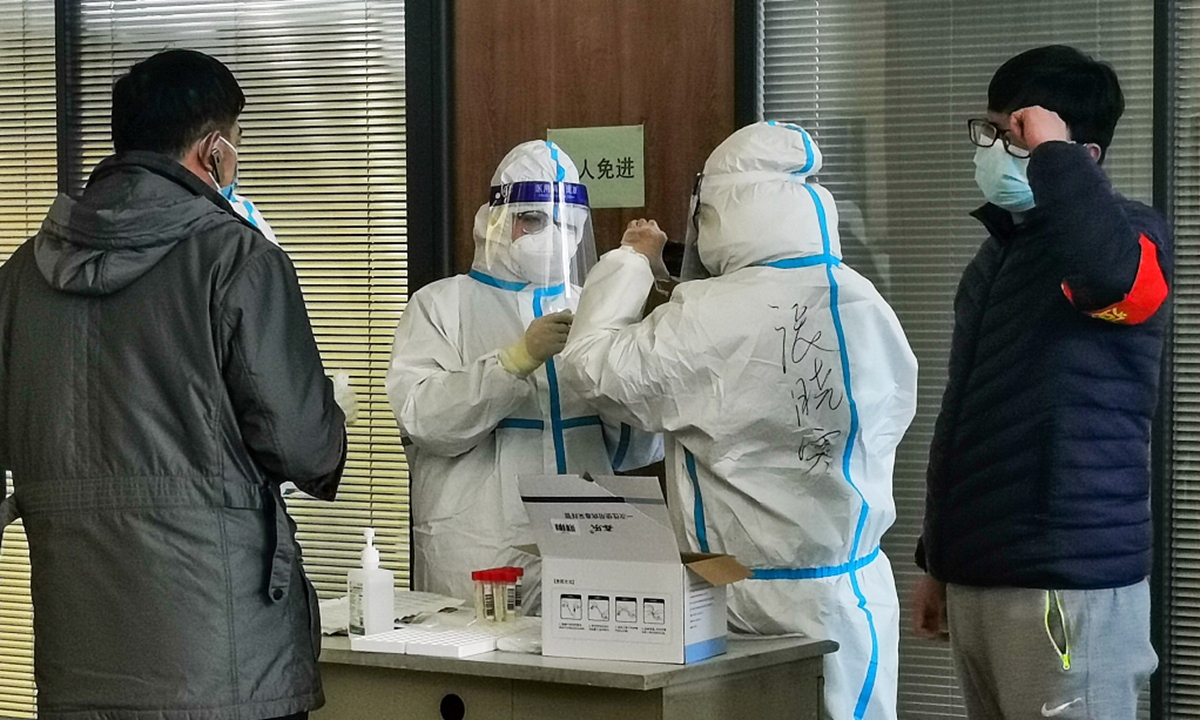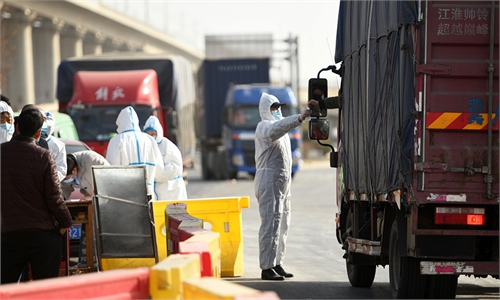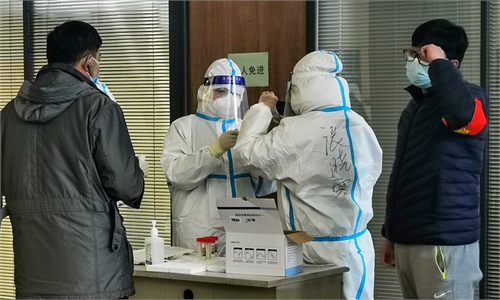Hebei outbreak sees record daily high, may date back to early November
‘Patient Zero’ may date back to early November

Shijiazhuang in North China's Hebei Province starts its second round of mass nucleic acid testing on January 12.Photo: VCG
North China's Hebei Province on Wednesday saw record daily infections since the outbreak started on January 2, with 90 confirmed and 15 asymptomatic COVID-19 patients reported. Experts said such high level of daily reported infections, which may actually date back to early November, is likely to last for another week.
Among the new infections, 84 were confirmed cases from Shijiazhuang, the capital city of Hebei Province.
Many had been to weddings and funerals or worked at schools before they were confirmed as infected. Some of their travel routes included East China's Shandong and Zhejiang Provinces, and North China's Shanxi and Shaanxi Provinces, according to Hebei health commission's website on Wednesday.
Previous reports showed that Beijing, as well as Wuhan in Central China's Hubei Province, Southwest China's Guizhou and South China's Guangxi Zhuang Autonomous Region, had found close contacts related to the Hebei outbreak.
Despite the daily surge, experts urged the public not to worry about the further spread of the virus, as anti-epidemic measures taken by Shijiazhuang in early January have quarantined related patients and their close contacts, adding that a high level of daily reported infections is expected to last for another week before showing a downward trend.
It has been 11 days since Hebei reported its first case, and based on experience, it usually takes two to three weeks to clear new infections, which means the Hebei outbreak is expected to be brought under control soon, Feng Zijian, deputy director of the Chinese Center for Disease Control and Prevention (China's CDC), told a press conference on Wednesday.
There is no need to overreact to the daily surge, as potential patients and close contacts are already being closely monitored and quarantined after Shijiazhuang rolled out anti-epidemic measures in early January, which means that there will not be any new source of infections, Yang Zhanqiu, a deputy director of the pathogen biology department at Wuhan University, told the Global Times on Wednesday.
He said that the increasing number of confirmed and asymptomatic infections suggested the big cardinal number relating to the outbreak started in Xiaoguozhuang village, Shijiazhuang.
About two weeks have passed since the first case on January 2, and the outbreak in Shijiazhuang is entering a stage in which the majority of patients have displayed symptoms or tested positive. Newly confirmed or asymptomatic infections will likely remain at a high level in the following seven days, Yang explained.
Zhang Yuexin, an expert based in Xinjiang Uygur Autonomous Region, told the Global Times that there have been at least three generations of spread since December 15, which explains such a high number of new infections.
Tian Lili of the Beijing municipal disease prevention and control department, who has been to Shijiazhuang to conduct epidemiological studies and trace the source of infection, said that the initial cases from this outbreak were elderly people from villages in Gaocheng district.
They had been to social gatherings, weddings and funerals, but there was no evidence to show they had ever come into contact with imported COVID-19 cases or imported products, Tian said, which means that there was an earlier generation of COVID-19 cases before.
Tian said experts have moved their focus in tracking the "patient zero" of the infections to the period between early November and December 15.
Evidence showed that the virus spread silently among locals for some time in Hebei before being detected, demonstrating the great challenges posed by silent carriers, experts reached by the Global Times warned.
However, Chinese officials said on Wednesday that asymptomatic infections are unlikely to cause a major outbreak in China, because silent carriers usually carry lower viral loads, and thus have weaker infectivity. They urged the public not to lower its guard against anti-epidemic measures as Spring Festival approaches.
As for the source of the outbreak in Hebei, Tian said this round of tracing may be the most difficult, explaining that Hebei villages are neither close to the country's borders nor do their residents have the habit of consuming seafood. However, their locations are close to the airport, which means it is possible the outbreak started with contaminated food or infected people from overseas.



